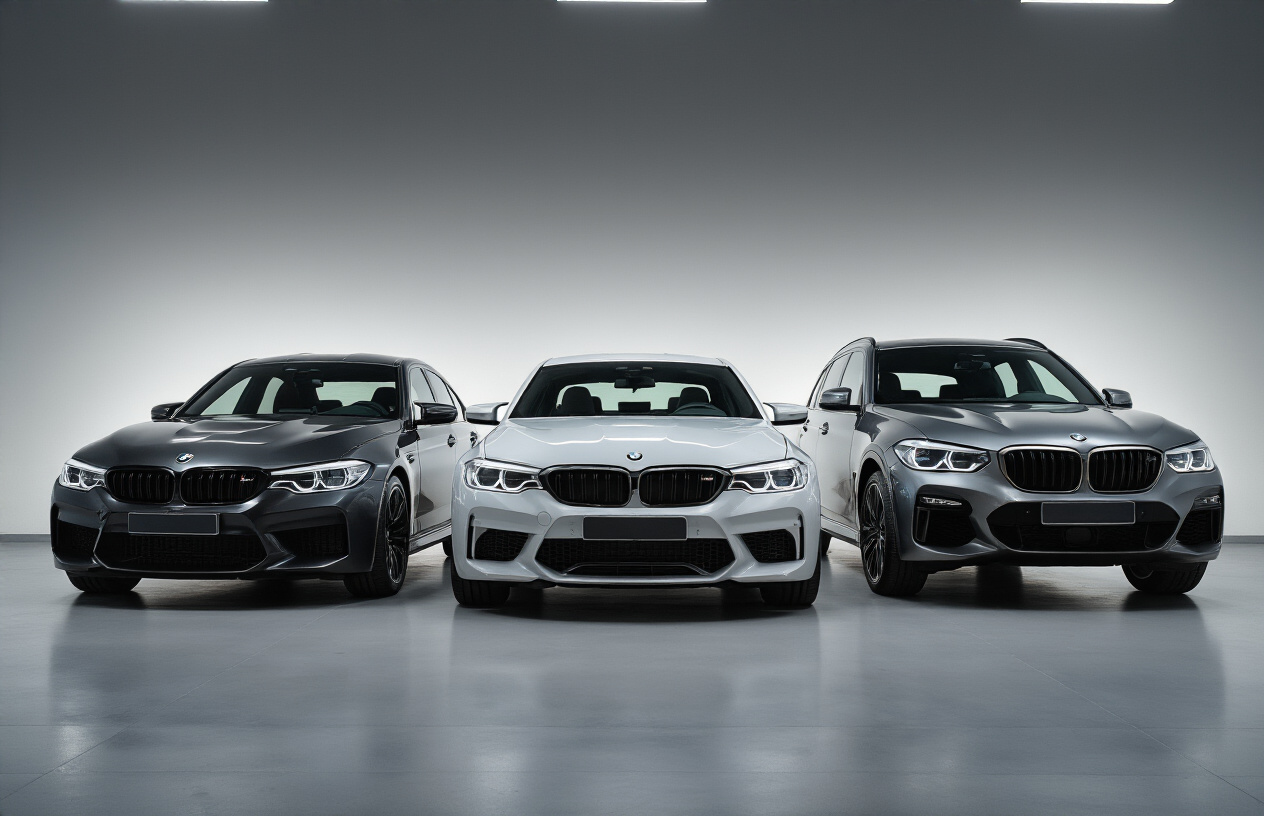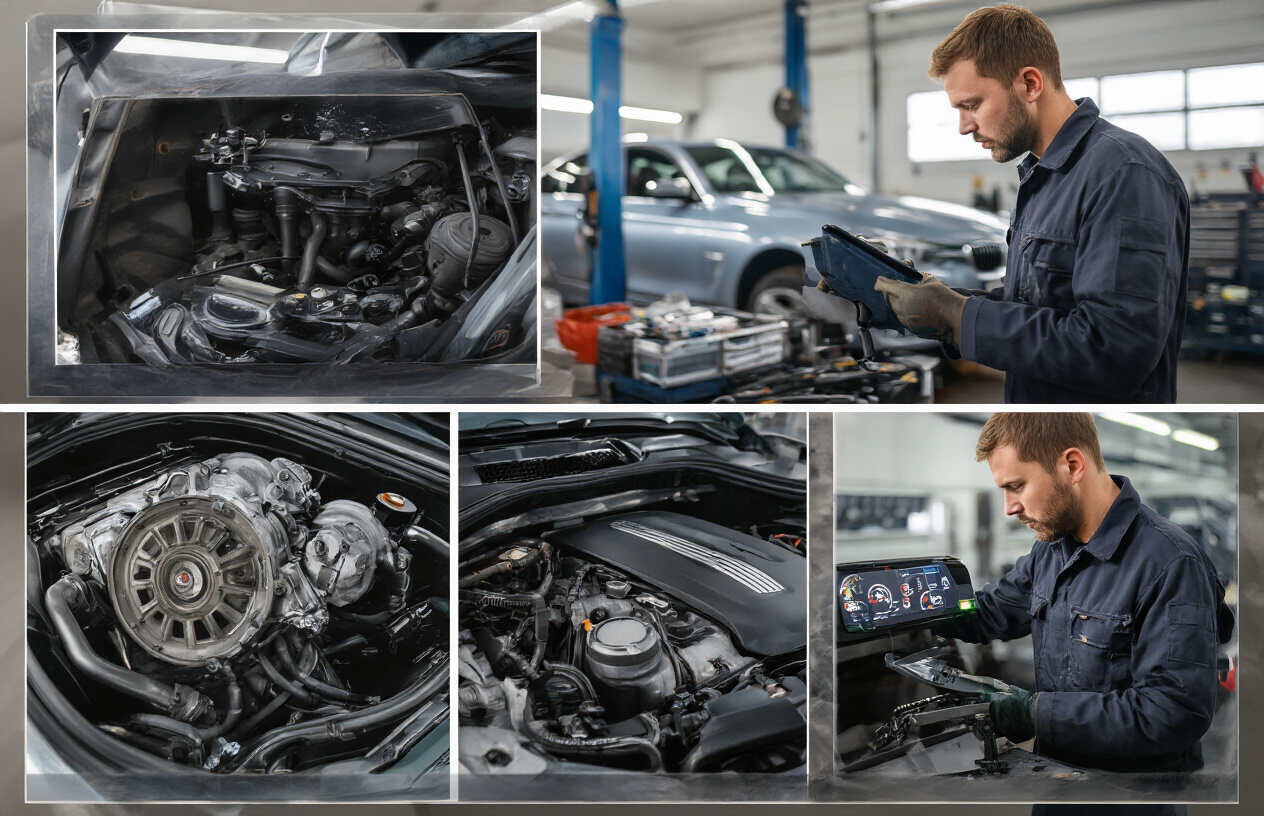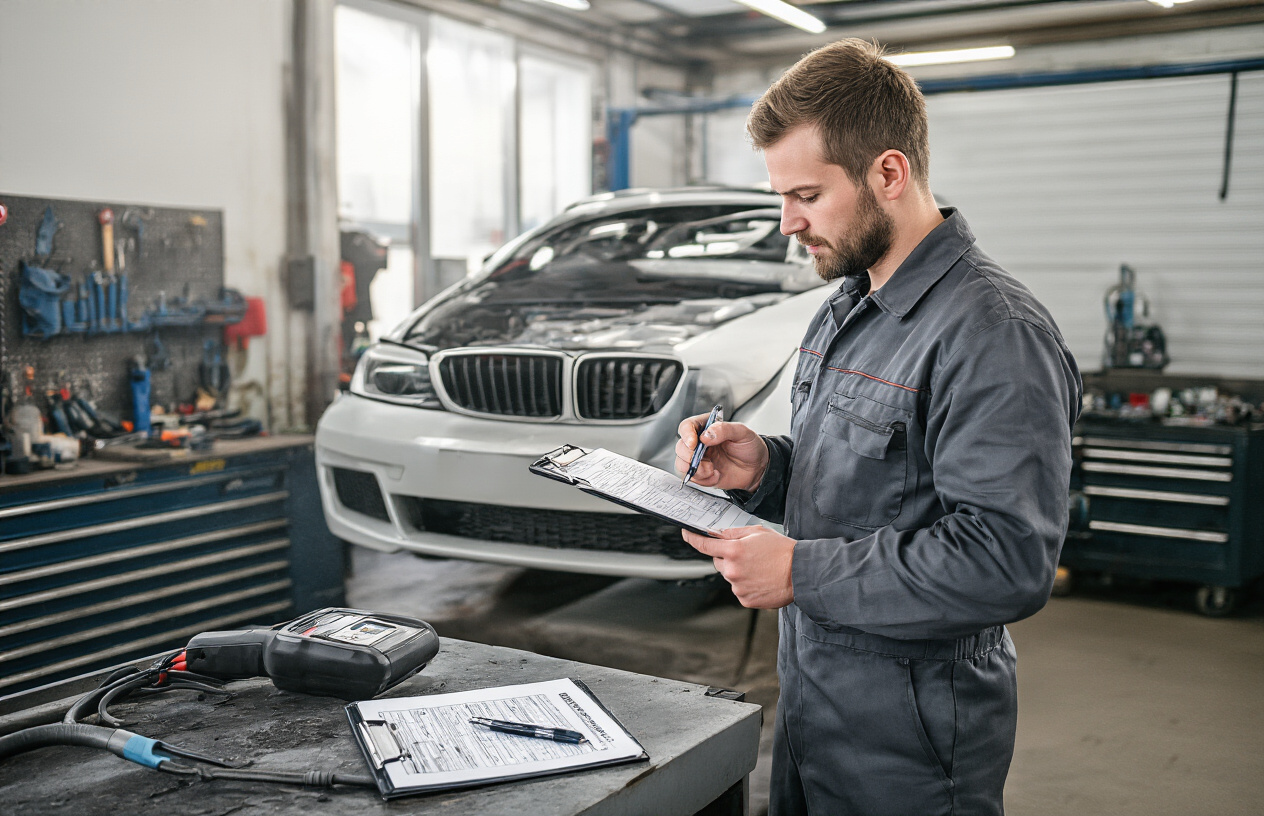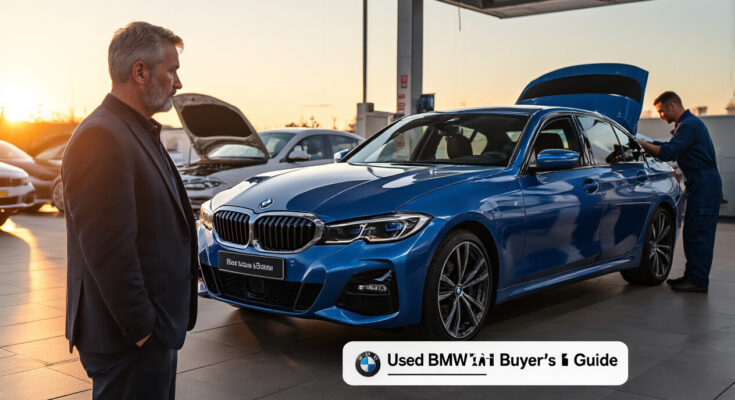You’re scrolling through listings, dreaming about that sleek BMW in your driveway, when panic hits: “What if it’s a money pit waiting to happen?”
I get it. Buying a used BMW feels like navigating a minefield of potential problems while chasing that ultimate driving experience.
The truth about used BMW ownership isn’t what most dealerships want you to hear. Before dropping serious cash on that German engineering, you need the real story on maintenance costs, reliability issues, and which models actually hold their value.
By the time you finish reading this guide to buying a used BMW, you’ll know exactly which warning signs send experienced owners running for the hills – and the hidden gems that might be worth every penny.
So what’s the one model year that mechanics unanimously tell their friends to avoid?
Popular BMW Models Worth Considering

The Reliable 3 Series: Best Years and Trims
BMW’s 3 Series is basically the gold standard for luxury compact sedans. The sweet spot for used models? 2016-2019 F30 generation cars have sorted out most early production issues.
Look for the 330i with the 2.0L turbo four-cylinder—plenty of punch without the maintenance headaches of the six-cylinder options. The 2017 facelift models got improved infotainment and slightly better reliability scores.
If you want the six-cylinder anyway (and who could blame you?), the 340i is magical but keep money aside for potential cooling system repairs after 60,000 miles.
Avoid the 2012-2013 models—they had timing chain issues that could trash the engine. The sweet spot for value? A 2017-2018 330i with the M Sport package gives you the looks without the full M-car costs.
Luxury Performer: 5 Series Buying Guide
The 5 Series is where BMW really flexes its luxury muscles while keeping things sporty. The F10 generation (2010-2016) has depreciated beautifully, making them attainable luxury bargains.
The 535i hits the right balance of power and reliability. Post-2014 models got updates fixing many early issues. The 550i V8 is tempting but prepare for potential turbo issues—budget accordingly.
The G30 generation (2017+) is significantly better tech-wise but costs more upfront. Worth it if you can swing it.
My insider tip? A 2015-2016 535i with M Sport and Premium packages. You’ll get 90% of the newest 5 Series experience for 50% of the price.
X Series SUVs: Family-Friendly Options
BMW’s X Series transformed from “why would BMW make SUVs?” to “wow, these are actually great to drive.”
The X3 is the crowd-pleaser. The 2018+ models are substantially better than earlier generations, with the xDrive30i offering the perfect balance of power and efficiency. Skip the first-year models (2018) if possible—they had some infotainment glitches.
The X5 is the family hauler with attitude. The F15 generation (2014-2018) has hit the sweet spot of depreciation. The xDrive35i six-cylinder is more reliable than the V8 options. Watch for air suspension issues on higher-mileage examples—they’re expensive to fix.
For larger families, a 2017+ X5 with the third-row option works, though those seats are best for kids or shorter adults.
M Series Performance Cars: What to Expect
M cars aren’t just BMWs with more power—they’re completely different animals with unique engines, suspensions, and attitudes.
The M3/M4 (F80/F82 generation) gives you supercar acceleration with sedan practicality. 2016+ models had some updates fixing early issues. Be wary of cars with extensive track use—look for service records.
The M2 is the hidden gem—smaller, more playful, and often cheaper to maintain than its bigger brothers. The 2017+ models with the Competition package are especially desirable.
For M5 shoppers, the F10 generation (2011-2016) offers incredible bang for your buck, but budget for potential fuel system and bearing issues after 50,000 miles.
All M cars demand religious maintenance. If the previous owner skimped on service, walk away no matter how good the deal seems.
Common Issues to Watch For

A. Engine Problems and Their Warning Signs
BMWs pack some serious engineering under the hood, but they’ve got their quirks. The N54 and N55 engines? Notorious for high-pressure fuel pump failures. You’ll know it’s happening when your car hesitates during acceleration or simply refuses to start.
Timing chain issues plague many models, especially the N20 and N47 engines. Listen for that telltale rattle on startup—it’s your warning bell before a $4,000+ repair bill lands in your lap.
Oil leaks aren’t just annoying, they’re practically a BMW birthright. Valve cover gaskets and oil filter housing gaskets love to seep, leaving those dreaded oil spots on your driveway.
B. Electrical System Failures
BMW’s electrical systems can be downright temperamental. The infamous CCC/CIC iDrive systems in 2006-2012 models crash more often than Windows 95. If the screen freezes or goes black during your test drive, run away.
Window regulators break with alarming frequency. That grinding noise when you hit the window button? That’s the sound of money leaving your wallet.
Battery drain issues plague many models. If the previous owner mentions “having to jump it occasionally,” what they really mean is “there’s an electrical gremlin I couldn’t fix.”
C. Transmission Concerns
The ZF automatic transmissions are generally solid, but watch for jerky shifts or hesitation—signs the transmission fluid hasn’t been changed (yes, despite BMW’s “lifetime fluid” nonsense).
Manual transmission BMWs might have clutch judder or a heavy clutch pedal, pointing to a clutch replacement in your near future.
The transfer case in xDrive models is another weak point. Whining noises or vibrations at highway speeds mean trouble brewing.
D. Cooling System Vulnerabilities
BMW cooling systems have a self-destruct timer set to roughly 60,000-80,000 miles. Water pumps (especially electric ones), thermostats, expansion tanks, and radiators—they’re all ticking time bombs.
Coolant leaks show up as sweet-smelling puddles under the car or white crusty residue around hose connections. Ignore them at your peril.
Overheating even once can warp cylinder heads in these precision engines. Check the temperature history in the onboard computer if possible.
E. Suspension and Steering Weaknesses
Control arm bushings wear out faster than your patience will. Clunking noises over bumps? That’s your first red flag.
The steering rack can develop leaks or play, making the steering feel loose or inconsistent. It’s not just annoying—it’s dangerous.
Run-flat tires fitted to many BMWs ride harshly and cost a fortune to replace. Many owners convert to conventional tires, but this requires carrying a spare or tire repair kit.
Rear subframe mounts can actually tear away from the chassis on some E46 and E9x models—a catastrophic failure that’s expensive to repair properly.
Inspection Checklist Before Purchase

Essential Documents to Review
Never hand over cash without checking these papers first. The vehicle title should be clean, with the seller’s name matching the one on the title. If it doesn’t, walk away – something’s fishy.
The vehicle history report is your best friend. CarFax or AutoCheck will show accidents, flood damage, title problems, and ownership changes. Multiple accidents? That’s a red flag waving in your face.
Don’t forget to verify the VIN numbers match on all documents and the car itself. Mismatched numbers usually mean stolen parts or worse.
Check that emissions and safety inspections are current. An expired inspection could mean expensive repairs are needed to pass.
Test Drive Assessment Points
BMWs should drive like BMWs – that’s why you’re paying the premium. Listen for strange noises when turning, braking, or accelerating. Clunks, rattles, or whines aren’t normal, no matter what the seller claims.
Take it on the highway. A proper BMW should feel planted at speed, not float or wander. Check acceleration from 30-50 mph and 50-70 mph – it should be smooth and responsive.
Test all electronic systems. BMWs are packed with tech that costs a fortune to fix. Make sure the iDrive system works flawlessly, along with all power features.
Pay attention to how the transmission shifts. It should be nearly imperceptible in an automatic. Manual transmissions shouldn’t grind or pop out of gear.
Professional Pre-Purchase Inspection Benefits
A dealer inspection might cost $200-$300, but it can save you thousands. BMW-specific issues often hide from untrained eyes.
These mechanics will plug in diagnostic computers that read fault codes even if warning lights aren’t on. They’ll find issues the seller hoped you’d miss.
You’ll get a detailed report that works as both a buying guide and a negotiation tool. Found problems? Knock that off the price or walk away.
An inspection also reveals upcoming maintenance needs. Timing chains, water pumps, and control arm bushings aren’t cheap on BMWs.
Checking Service History Records
The service history tells the real story of a BMW’s life. Regular maintenance at recommended intervals? Great sign. Gaps or missed services? Trouble ahead.
Look for BMW-specific maintenance like valve cover gaskets, oil filter housing gaskets, and cooling system overhauls. These should be done preventively.
Digital service records from BMW dealerships are gold. They can’t be faked and show exactly what was done and when.
Check if recalls were addressed. BMW has had some serious recalls, including airbag issues that could be dangerous if ignored.
Understanding Ownership Costs

A. Maintenance Schedule and Expenses
Owning a used BMW isn’t just about the purchase price—it’s about what comes after. BMW maintenance costs will hit your wallet harder than most mainstream brands.
A typical BMW needs service every 10,000 miles, with major services at 30,000, 60,000, and 90,000 miles. These big services? They’re not cheap. We’re talking $1,200-$1,800 for that 60,000-mile service on a 3-Series.
Oil changes run $150-$300 at dealerships—about triple what you’d pay for a Toyota. And those brake jobs? Expect to shell out $700-$1,000 for parts and labor.
The real budget-busters come after warranty expiration:
- Water pump replacement: $800-$1,200
- Valve cover gasket: $400-$700
- Control arm replacement: $500-$900
B. Insurance Rate Factors
BMW insurance costs about 30-50% more than average vehicles. Why? Three big reasons:
- Repair costs are sky-high (luxury parts aren’t cheap)
- They’re theft targets (that roundel logo attracts the wrong attention)
- Many models pack serious performance (insurers see risk)
Your location, driving history, and specific model drastically affect rates. An older 320i costs way less to insure than an M4. Get quotes before buying—that sweet deal might not look so sweet after insurance kicks in.
C. Parts Availability and Pricing
BMW parts pricing follows one simple rule: brace yourself. OEM parts cost 2-3 times more than comparable parts for non-luxury vehicles.
The good news? Parts availability isn’t usually an issue for models from the last 15 years. The aftermarket has caught up, offering quality alternatives at 30-50% savings.
Some common parts pricing:
| Part | OEM Cost | Aftermarket Cost |
|---|---|---|
| Air filter | $70-90 | $25-40 |
| Brake rotors (front pair) | $300-400 | $120-200 |
| Oxygen sensor | $250-350 | $100-180 |
Older and rarer models create parts headaches—both in finding them and affording them.
D. Fuel Efficiency Expectations
BMW fuel economy might surprise you—in both directions.
Modern 4-cylinder models (like the 320i/328i) can achieve 25-30 MPG combined. Not bad! But those delicious inline-6 and V8 engines? They’re thirsty beasts demanding premium fuel.
Real-world numbers often fall short of EPA estimates, especially in performance-oriented models. That M3 might claim 20 MPG highway, but drive it like you bought it for and you’re looking at 15-17 MPG.
Also, turbocharged models (anything with “t” or “ti” in the name) can be efficient on paper but gulp fuel under spirited driving.
E. Depreciation Considerations
The first owner already took the biggest depreciation hit—good news for you! But BMWs continue to depreciate faster than many brands.
Expect your BMW to lose 15-20% of its value in the first year after you buy it used, then 10-15% annually for the next few years.
Some models hold value better:
- M models (especially limited editions)
- Coupes and convertibles (especially 2-door models)
- Diesel models (increasingly rare and efficient)
Models with known reliability issues depreciate faster. That cheap V8 7-Series? There’s a reason it costs 70% less than its original MSRP after 7 years.
Consider buying a 3-4 year old BMW coming off lease for the best balance of modern features and reduced depreciation impact.
Smart Buying Strategies

Best Places to Find Quality Used BMWs
You know what’s crazy? Finding a quality used BMW isn’t actually that hard once you know where to look. Skip the random roadside lots and head straight to these goldmines:
-
Certified Pre-Owned (CPO) Programs: BMW’s own CPO program is the cream of the crop. These cars undergo rigorous 196-point inspections and come with extended warranties. Yeah, you’ll pay more, but peace of mind has its price.
-
Specialized BMW Dealerships: Shops that focus exclusively on BMWs often have mechanics who eat, sleep and breathe these German machines. They’ll know every quirk before you do.
-
Online Marketplaces: Sites like CarGurus, AutoTrader, and Cars.com let you filter exactly what you want. Pro tip: search within 200 miles of your location for the best selection without crazy delivery fees.
-
BMW Owner Forums and Groups: Enthusiasts selling to enthusiasts typically means well-maintained cars. Check Bimmerforums or Facebook BMW groups for private sales from owners who can tell you every oil change date.
Ideal Age and Mileage Range
The sweet spot for used BMWs? It’s all about finding that balance between depreciation and reliability:
-
2-5 years old: You’ll dodge the steepest depreciation hit while still getting relatively new technology.
-
30,000-60,000 miles: This range typically means the car’s broken in but hasn’t hit major maintenance milestones yet.
-
Model-specific considerations: Some BMWs age better than others:
| Series | Ideal Age | Sweet Spot Mileage | Notes |
|---|---|---|---|
| 3 Series | 3-4 years | Under 50,000 | Most reliable overall |
| 5 Series | 2-4 years | Under 45,000 | Higher repair costs after 60k |
| X3/X5 | 3-5 years | Under 55,000 | Check for suspension issues |
Avoid first model years after redesigns. They typically have more bugs to work out than later production years.
Negotiation Tips for Better Deals
Buying a BMW isn’t the time to be shy. Your negotiation game needs to be as refined as the car you’re buying:
-
Bring maintenance records research: Walk in knowing exactly what typically breaks on that specific model and year. Mention those potential costs during negotiation.
-
Get a pre-purchase inspection: Worth every penny of the $150-300 it’ll cost you. Use any issues found as negotiation leverage.
-
Time your purchase right: End of month, end of quarter, and December are golden times when salespeople are hungry to hit targets.
-
Start low, but be realistic: About 15-18% below asking price gives you room to negotiate without insulting the seller.
-
Focus on the total cost: Dealers love to distract with monthly payments. Keep your eye on the final number.
Warranty Options and Extended Coverage
That warm fuzzy feeling of protection doesn’t have to end when the factory warranty does:
-
Factory Warranty: New BMWs come with 4-year/50,000-mile coverage. If buying used, check how much is left.
-
CPO Extension: Certified pre-owned BMWs get an additional 1-year/unlimited mileage warranty after the factory coverage ends.
-
Third-Party Options: Companies like Endurance and CarShield offer BMW-specific plans, often at lower prices than dealer extensions.
-
What to Cover: At minimum, get powertrain coverage. For models with iDrive systems, technology coverage is worth considering too.
Remember, the cheapest warranty isn’t always the best deal. Check exclusions carefully and confirm the warranty company has a solid reputation for actually paying claims without a fight.




